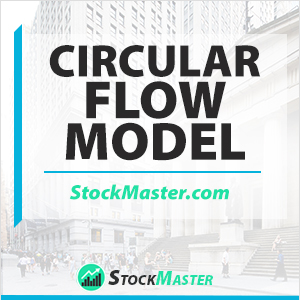 What is the Circular Flow Model?
What is the Circular Flow Model?
Definition: The circular flow model is a term used to describe how products and money move in an economy. Since civilized societies experience an endless flow of money on a daily basis, the circulation covers the flow of goods and services from producers to households or consumers in exchange for cash.
One thing to remember is that the flow of goods services and money does not occur at a constant rate all the time. An economy is likely to experience a high flow of goods services and cash in times of economic prosperity. In times of economic depression or recession, the flow of products and money remains at subdued levels. Therefore, the flow of products and money is highly dependent on economic cycles.
Leakages also do occur in the circular flow model. The leakages, in this case, may occur in the form of taxes imposed by the government that affects the amount of money in circulation for buying goods and services. Likewise, money paid to foreign companies also suppresses the circular flow of money in an economy.
Circular Flow Model Basics: How Money Flows In An Economy
The circular flow model is made up of two main categories.
- Goods and services
- factors of production
The market for goods and service
The market for goods and services assumes that households will always purchase finished products, consequently support the production process. In this case, money flows from households to firms in exchange for the goods and services on offer. As money flows from buyers to sellers in the circular flow model, households end up with finished products.
The market for Factors of Production
The circular flow model can only be completed by factoring in the factors of production that are crucial to producing services and goods. If goods and services were the only factors in the circular flow model, then firms would have all the money in an economy and households all the finished products. However, that doesn’t always happen
In factor markets, both firms and households play a different role. For starters, households provide the much-needed labor used in the service and good production. Likewise, households are considered sellers of factors of production. Firms, on the other hand, must pay for the labor provided by the households in the form of wages.
Factors of Production: Goods and services combination
A closed-loop, therefore, exists in the circular flow model, indicating the flow of money as well as the impact of factors of production. Likewise, the closed-loop leads to continued economic activity in the end. The closed-loop is simplified in several ways, given the lack of a government on the chain.
However, it can also be extended to include the government, which performs different roles. For instance, the government can come in between households and factor markets to charge taxes on the income that laborers earn.
Likewise, the government also charges taxes on any revenue that firms generate on the sale of services and goods produced.
Assumptions in the Circular Flow Model
One of the main assumptions taken into consideration in the circular flow model is that the household sector is made up of consumers. The consumers, in this case, have disposable income that they spend on goods and services to satisfy their needs and wants. In some instances, it is assumed that households spend all their money on goods and services.
Likewise, the circular flow model also entails the business sector made up of firms that operate in the economy. The companies, in this case, use their resources to produce goods and services to meet prevailing market demand.
The government too has a pivotal role to play in the circular flow model. Made up of all agencies from local state to the federal level, the government is tasked with the responsibility of passing legislation that enables the proper functioning of the market. Likewise, the government also bills the network by charging taxes on income generated.
